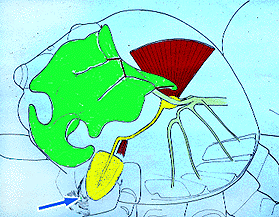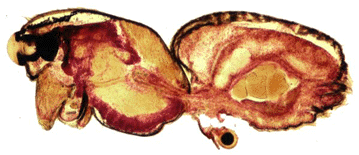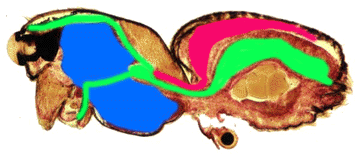Go to jumping spider anatomy page
The digestive tract or gut of a jumping spider is rather strange from
a vertebrate's perspective. From the mouth, a shovel-shaped pharynx
leads into the esophagus. The mouth is shown in blue here:


The esophagus passes straight through the brain to arrive at the sucking stomach, shown as a yellow bulb in the image above. The sucking stomach has muscles surrounding it and attached to it, including the fan-shaped muscle shown in red which connects to the inside top of the carapace. Up to the sucking stomach, the gut is lined with cuticle, meaning it is technically part of the spider's exoskeleton. Remarkably enough, this means that when the spider sheds its skin to grow, it has to shed its esophagus and stomach, pulling them out through the brain in the process!
Beyond the sucking stomach the gut is no longer lined with cuticle,
and it begins to branch. Branches extend into the bases of the legs,
and one branch extends up and forward to a large diverticulum lying
over top of the eyes and brain (perhaps the eye
movement helps to keep the food moving around!). A main branch of
the gut continues posteriorly from the sucking stomach into the abdomen
(opisthosoma). To show you another view of the digestive system, here
is a longitudunal section through a small jumping spider:


The anterior end is to the left; note the eye lens on the extreme left
and the spinnerets on the right. Here is the same section colored, showing
the gut in green (brain in blue and heart in red):


Note the esophagus passing through the brain. In the abdomen the gut branches into a spongy mass of passageways for digestion, and ends in the anus just above the spinnerets.
Jumping spider anatomy pages:
[Anatomy] [External] [Muscles] [Gut] [Vision] [Palpi] [Epigyna] [Gallery]



 Go to quick links
Go to quick search
Go to navigation for this section of the ToL site
Go to detailed links for the ToL site
Go to quick links
Go to quick search
Go to navigation for this section of the ToL site
Go to detailed links for the ToL site